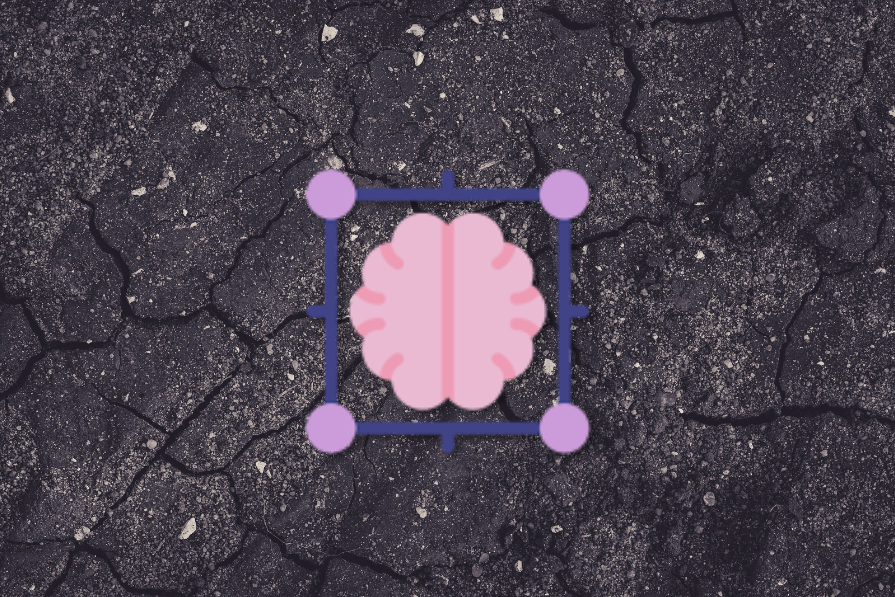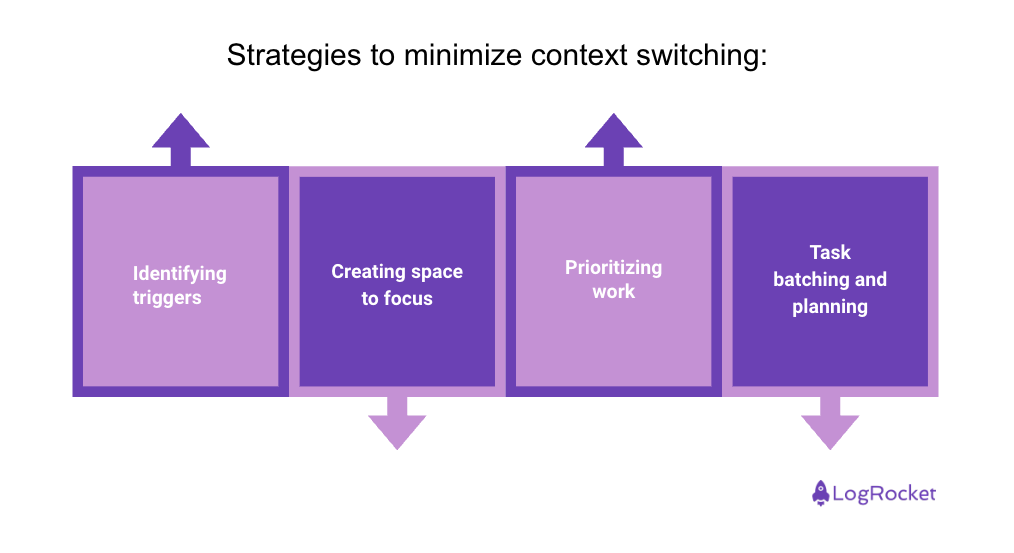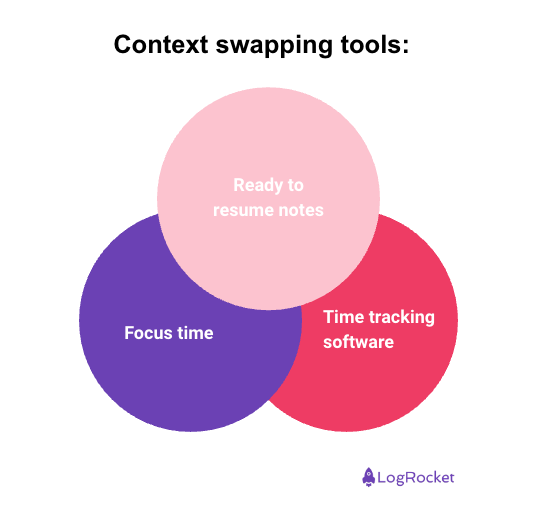Think back on your last hour of work. Try to remember every task you’ve touched. How many different things did you work on?

Context switching is when you shift your focus from one task to another. This requires you to disengage from one activity and re-engage with another. If the shifting happens too frequently, it could lead to mental fatigue, lack of productivity, and errors.
I worked on an important project with tight deadlines a few months ago. Days slipped by, and although I worked hard every day and felt drained after a day’s work, I was hardly making a dent in the project.
I then audited my work day and where I spent my time. I was so busy, but what was I doing? I noticed that I was jumping between tasks and responsibilities too often. And I was not giving this project the focus it needed. I was distracted by multiple tasks, projects, questions, and meetings. I end the day exhausted, feeling like I haven’t made meaningful progress.
Have you had a similar experience? Keep reading to learn how you can manage context-switching to be more effective in your work.
Imagine that you have to buy bread. On your way to the shop, a friend messages asking if you want to join her for coffee. You change direction and join her to catch up (this is like a colleague asking a question or another meeting).
Afterward, you pop into the hardware store opposite the coffee shop to buy some items for a DIY project at home (this is like another project). You finally arrive at the grocery store two hours later to buy the bread, only to find that the bread you wanted was sold out, and you had forgotten the rest of your shopping list at the coffee shop.
Context switching is different from multitasking. Multitasking involves doing two or more tasks simultaneously, while context switching involves switching from one task to another.
For example, if your goal were to go to the grocery store to buy bread, multitasking would be going through the bread aisle looking for the bread while messaging a friend and taking pictures of potential ingredients for a future dinner you’re planning. Ultimately, you get home only to notice you bought the wrong bread, the pictures are blurred, and you can’t remember what your friend told you! By multitasking, you don’t focus on particular tasks and miss out on doing any of them well.
The problem with context switching is the cost of constantly shifting between tasks.
Switching to a new task takes time to get into a new flow, whether you’re jumping to a new task, attending a meeting, or addressing a question. After a distraction, it takes around 23 minutes to regain focus, decreasing overall productivity. Productivity may suffer a reduction of 40 percent, according to studies conducted by the American Psychological Association. It often takes more time to pick up a task again than just completing it without interruptions.
Frequent task switching, known as “toggle tax,” can lead to fragmented attention, reduced work quality, and increased completion time. You lose momentum on the existing task and struggle to pick it up again. You can’t immerse yourself in the task if you need to hop on a meeting or new tasks in a few minutes. Excessive toggling increases the brain’s production of cortisol, slows you down, and makes it harder to focus.
Thoughts about a previous task can linger while you try to focus on another, a phenomenon coined by Sophie Leroy as “attention residue.” As a result, you’re never entirely focused on the new task at hand. This not only slows you down as you struggle to reestablish the new context, but it also reduces your effectiveness.
Too much context switching leads to too much time regaining context rather than completing the work. Ultimately, this can result in a lack of productivity and a sense of mental fatigue and stress due to a perceived lack of progress. It can also impact the quality of your work.
There is a cognitive load involved in context switching. Your brain needs to retain information about multiple tasks. For every switch between tasks, your brain must reset from what it has been busy with, draining energy and focus.
Continuously switching between various tasks and activities strains cognitive resources and leads to feelings of fatigue and overwhelm. Scientific studies show that every switch between tasks takes up mental energy and can tire you.
When I realized I was switching contexts too much, I set out to regain control of my productivity. I’ve tried a couple of strategies to work with context switching, and I will share with you what worked well for me:

Start by identifying the triggers in your workday that lead to you switching contexts and shifting between multiple tasks and projects.
You can do this by tracking the different things you work on in a day, noting down meeting goals and how they relate to your work and the time you spend on tasks.
For me, the triggers are:
It’s up to YOU to organize your time and way of working so that you can manage context switching. Create time to focus and minimize distractions. Manage your day, calendar, and way of working so you have time to focus.
For me, it works to block out time in my calendar when I’m unavailable for others or meetings, and I focus on something specific. I use this to create space to do deep work with a particular focus. It has to be at least one hour long so that I can allow time to get into the job again.
This is where you focus on one task and only do that for a specific period. Your brain doesn’t have to think of checking anything else as you’re only focused on this one task. All your energy and mental capacity can be directed here. I minimize distractions by putting my phone away for these blocks, and I mute messaging platforms, and notify my colleagues that I won’t be as responsive during this time.
Now that you have time and space to focus on one context, prioritize your work for the day and be strict about how you spend this time.
I use this time for the most important thing. To decide what to focus on, I usually list everything on my plate, including the goals I want to achieve and when. I write down everything that is needed to do them. I mark the most important things that will move the goal forward. And I focus on the top one.
Since the space to focus on this is limited, it’s helpful to be biased to action and to adopt the mindset that getting things done is better than being perfect.
When you make a list of things on your plate, you’ll notice that some tasks are smaller tasks that require less focus from you, and you can jump in and out of them. The cost of the switch isn’t that high. For example, meetings, conversations, or updates.
Batch the tasks that require a similar work style and plan time to focus on them. You might jump around between them a lot, but it’s okay. It’s intentional context switching that you’ve planned.
I set out time blocks where I’m responding to many things. Also, at any time in the day when I notice that my focus gets disrupted, I lean into it and use the next 20 minutes to catch up on all the messages, updates, and questions.
If you need more help reducing context switching, these are my top techniques that have helped me to be more effective:

Before switching contexts, take a moment to note where you are in your progress on the original tasks and what needs to happen next. This’ll make it much easier to switch back to the task and get back into it again.
This has helped me when I have back-to-back meetings and switch contexts in every meeting. When I have time to act on the discussions from the meeting, these notes make it faster to get the context of the meeting again.
You can use any note-taking app, good old pen and paper, or edit the AI summaries of meeting notes.
Dedicate a portion of your day to meeting-free zones so you don’t have to switch contexts during this time.
This has helped me create space in my day to focus on the most critical project. It’s also a time when I’m in control and can minimize context-switching.
You can use tools like Clockwise or add blocks for focus time in your calendar when no meetings can be booked. Remember to mute your notifications during this time, too, so you don’t get distracted. The Pomodoro Technique could also help you ensure you only focus on one context during the focus time blocks.
Capture time spent on various tasks and applications without manual input to provide an accurate overview of your work habits.
This has helped me to identify how I use my time, how often I switch contexts, and ultimately, to have more control over these interruptions.
Tools like Timeular or Timely make tracking your time easy without manual input. Otherwise, making notes could also work, but it’s less reliable and requires more work.
Below are case studies where strategies to reduce context switching have been successfully introduced:
Atlassian implemented Clockwise, an AI-powered scheduling tool, to optimize meeting times and protect focus periods for its teams. This approach reduced context switching and enhanced productivity for Atlassian, creating a culture that respects individual work rhythms.
An MIT Sloan Management Review study examined organizations that introduced meeting-free days to minimize context switching. This revealed significant improvements in productivity, collaboration, and employee satisfaction due to uninterrupted time, allowing for a better focus on tasks.
This research, highlighted in the Harvard Business Review, explored how companies addressed meeting overload by critically evaluating the necessity of meetings and empowering employees to decline non-essential meetings. This strategy reduced context switching associated with meetings, decreased stress levels, and helped to foster a more efficient and engaged workforce.
Returning to the example of buying bread, if you didn’t have to switch contexts, you would have gone straight to the shop and bought the bread in 10 minutes.
Similarly, you’ll be much more focused on the task without the daily overload of context switches. You’ll complete projects faster and better as you can focus solely on them and feel less overwhelmed and tired.
For the next week, I challenge you to choose one strategy and try it to reduce the impact of context switching. Create space to focus, prioritize work, and get it done. Your productivity, energy, and peace of mind are worth it, and your future self will thank you for it.
Featured image source: IconScout

LogRocket identifies friction points in the user experience so you can make informed decisions about product and design changes that must happen to hit your goals.
With LogRocket, you can understand the scope of the issues affecting your product and prioritize the changes that need to be made. LogRocket simplifies workflows by allowing Engineering, Product, UX, and Design teams to work from the same data as you, eliminating any confusion about what needs to be done.
Get your teams on the same page — try LogRocket today.

A practical guide for PMs who want to stop being bottlenecks, delegate smarter, and lead teams effectively with a clear ownership framework.

Stop letting unreliable data block features. Treat data as inventory to track quality, ownership, and ship with confidence.

Learn why slide decks slow teams down and explore better tools like whiteboards, PRDs, and prototypes to improve collaboration and alignment.

AI PM roles are evolving fast. Learn the five types of AI PMs, the skills they need, and how they shape AI products across industries.